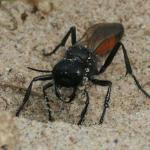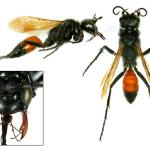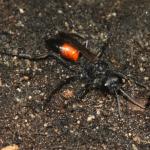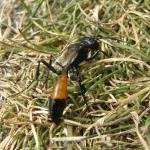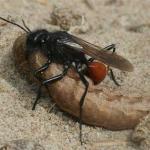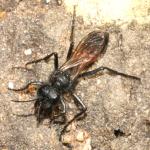The range of P. hirsuta extends along the southern and western coasts from West Sussex to Lancashire. There are also a few scattered inland localities. An apparently separate population is found on the Norfolk coast. Its range may overlap with that of P. affinis. The species is also present on Guernsey (Luff, 1904, 1905a) and Jersey, but on the latter it is difficult to distinguish from the very similar P. luffii (a species not known from mainland Britain).
Listed in Falk (1991) as Nationally Notable (Nb).
A mainly coastal species and one which is often locally common on sandy soils.
Females fly from late March to mid-September, males from the end of June to the beginning of September. Maneval (1939) showed that females (but not males) overwinter as adults, presumably after mating. Autumnal clusters of up to several hundred females have sometimes been found in rock crevices and other protected situations in continental Europe. Given the long flight period, it would be interesting to know whether the offspring of overwintering females themselves overwinter without nesting, as in the pompilid Anoplius viaticus, or whether some of them nest to produce a second generation which overwinters.
As in most Podalonia species, many of the prey of P. hirsuta are large, naked 'cut-worm' noctuid larvae which spend daylight hours in underground burrows and therefore have to be dug out by the female wasp. Diurnally active prey species have also been recorded, however, including some that are hairy.
In most Podalonia species, including P. hirsuta, the prey is generally captured before nest construction, whereas in Ammophila this sequence is usually reversed, though there are exceptions to this generalisation in both genera (see under P. affinis). The unicellular nest is invariably provisioned with one large caterpillar, whereas more than one is often used by Ammophila. While the wasp is digging her burrow, the paralysed caterpillar is typically left in a small tuft of vegetation, which probably reduces the risk of it being discovered by predators, such as ants, or of desiccating on the hot sand. The burrow is oblique and 6-7 cm long. When it is complete, the prey is pulled into the cell, oviposited on, then the nest entrance closed using sand and debris. Steiner (1975) reports that females commonly open other females' nests and carry off their prey, as also occurs in Ammophila.
Bramble, willow and thyme.
Bougy (1935) records a species of Hilarella (Diptera: Miltogramminae) parasitising P. hirsuta in continental Europe.


